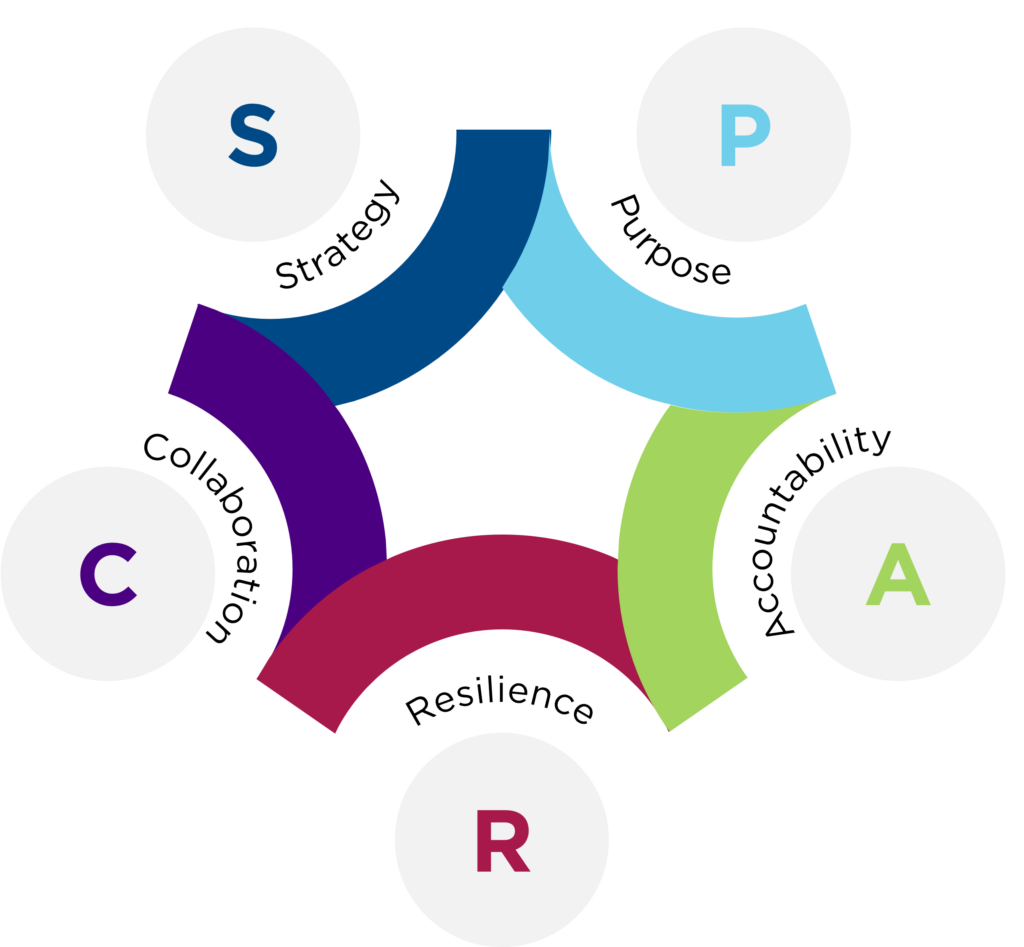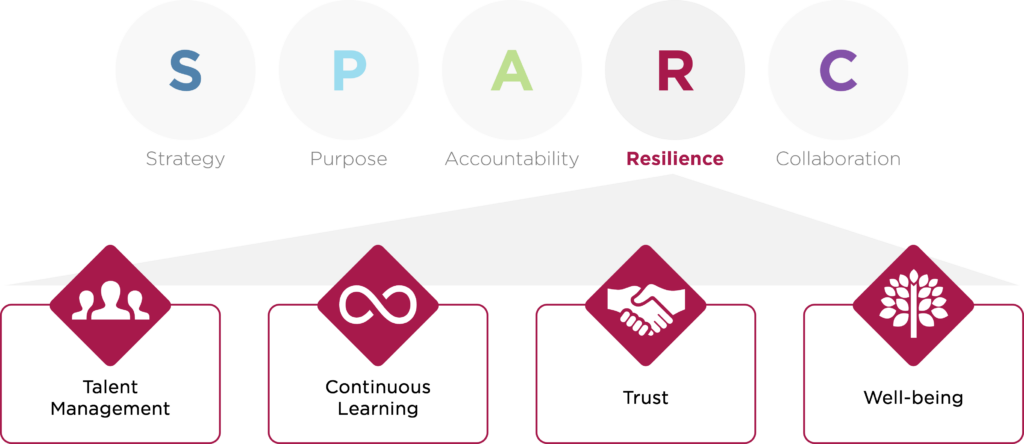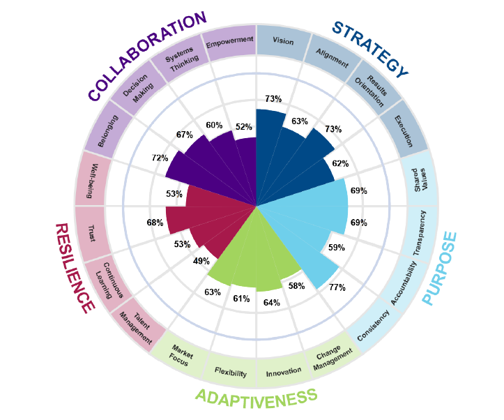We’re doing business every day in a marketplace more dynamic than ever before. Continuous change can be exhilarating; it drives innovation and has the potential to turn challenges into unmatched opportunities — if an organization is fit for the task. You may be adept at leading the day-to-day business as a leader, but how do you transform the business to meet the dynamic marketplace?
Bridging the insights from the Global CEO Outlook with the imperative for transformation, it’s clear that agility and transformation are not just parallel tracks but deeply interconnected strategies for enduring success. CEOs understand that agility — the ability to adapt swiftly and effectively to changes — is foundational to staying relevant and competitive.
This agility, however, must be rooted in a broader organizational transformation that not only encompasses adapting to immediate changes but also instills behaviors and practices that drive sustained performance. Thus, the question of whether a company is prepared to meet performance goals amid challenges becomes a reflection of its commitment to both agility and transformation.
Being prepared is not just about the capacity to change but about embedding a transformative agility into the fabric of the organization, ensuring it can navigate both current and future challenges with resilience and strategic foresight.

Predicting Success: 5 Key Factors of Organizational Agility
Organizations that transform successfully are built on a culture of performance. At bluSPARC, we’ve identified five key factors that serve as predictors of organizational performance, agility, and success — Strategy, Purpose, Accountability, Collaboration, and Organizational Resilience.
- Strategy provides clear direction and goals.
- Purpose motivates and unifies teams.
- Accountability fosters responsibility and high performance.
- Collaboration enhances innovation and problem-solving.
- Organizational Resilience ensures adaptability in a changing environment.
These factors form the foundation of a robust and forward-thinking organization, poised to weather turbulent times and thrive in any market.

Looking Forward: Future-Ready Companies Prepare to Embrace Change
“The only thing constant is change,” and the past few years have reinforced this ancient wisdom. A global pandemic, political unrest, technological advancements, and workplace disruptions brought valuable lessons, perhaps most importantly that resilience and becoming future-ready demands organizational agility.
Transformation as the New Normal: the critical role of culture
In today’s business world, transformation has become the new normal for organizations striving to adapt and excel. It’s no longer an occasional event but an ongoing process.
Organizational transformation is the process of adapting to an evolving business environment and changing your organization’s existing culture to address a challenge or achieve a specific competitive advantage. This involves navigating change, aligning culture with strategy, and fostering resilience in the face of complexity and uncertainty.
One main ingredient in any transformation is your company culture. Simply put, your culture is how you do things. It shapes behavior and consists of jointly held beliefs around what’s expected and a shared purpose.
A high-performing organizational culture drives employee engagement and productivity. When employees feel connected to the company’s values, have a sense of purpose, and work in a supportive environment, they are more likely to be motivated, innovative, and committed to achieving the organization’s goals.
High-performing organizational cultures excel in a clear vision statement, strategic intent collaboration, innovation, and adaptability — crucial traits in the rapidly evolving business landscape. A resilient culture is what helps the organization to withstand and recover from setbacks and keep delivering what stakeholders want. This means these organizations are better equipped to respond to changes, tackle challenges, and seize opportunities.
Transformation and Resilience: An Evolutionary Symbiotic Process
Organizational transformation and resilience are intrinsically linked, acting as complementary forces that empower companies to successfully navigate and adapt within an ever-evolving business environment. The essence of this connection lies in the shared emphasis on adaptability and the capacity for continuous improvement.

Through organizational transformation, companies reconfigure their structures, processes, and cultures, thereby enhancing their agility and ability to swiftly respond to new challenges and opportunities. This transformation is not a one-off change but a step towards becoming inherently resilient, enabling organizations to not only withstand disruptions but also to emerge stronger from them.
Embedding practices such as agile project management, continuous feedback loops, and a culture of experimentation ensures that the organization continuously evolves, learns from experiences, and adapts over time. This ongoing cycle of transformation fosters organizational resilience, equipping companies with the dynamic capabilities necessary to thrive in a constantly changing landscape.
Transformation initiatives, such as digitalization, process redesign, or cultural shifts, not only respond to external pressures like market shifts or technological advancements but also bolster an organization’s resilience by making it more adaptable and robust against unforeseen challenges.
Conversely, a resilient organization is better equipped to undergo significant transformations, providing necessary support and stability to its workforce during periods of change.
The symbiotic relationship between organizational transformation and resilience is characterized by a dynamic feedback loop that fortifies a company’s ability to navigate and thrive in the face of uncertainty and change. Transformation initiatives, by overhauling processes, structures, and cultures, embed agility and adaptability at the core of the organization—key components of resilience.
Successful transformation primes organizations to not only tackle current challenges with enhanced responsiveness but also to proactively cultivate resilience for future disruptions. In turn, the resilient nature of an organization ensures the longevity and sustainability of its transformation efforts, fostering a culture of continuous improvement and readiness for change.
The intertwined processes create a powerful feedback loop, where each transformational step informed by resilience leads to further agility, and each resilient action is strengthened by previous transformations. This cycle ensures that agility and resilience are not just reactive measures but are deeply embedded within the organizational DNA, enabling companies to seamlessly adapt and evolve, leveraging challenges as stepping stones for innovation and growth.
Through this dynamic interplay, organizations can maintain stability and continue to thrive in the face of uncertainty, embodying a state of adaptive equilibrium that fosters sustainable evolution and growth.
Assessing Organizational Resilience: are you prepared for what’s to come?
Assessing organizational resilience, can help you determine if your organization is ready for what lies ahead, and if not, what steps must be taken to improve organizational agility.
Organizational resilience refers to a company’s ability to adapt and withstand challenges, disruptions, and crises while maintaining its core functions and effectively recovering from adverse events. It’s like a sturdy ship navigating through stormy seas, able to weather the waves and emerge stronger. Organizational resilience isn’t just “bouncing back”; it’s about bouncing forward by preparing your greatest resources, your people, with the skills and development opportunities to encounter challenges as opportunities.
Assessing organizational resilience requires looking at how well the organization is supported by talent management, a culture of continuous learning, trust among members, and a focus on overall well-being — all elements that ensure an organization can withstand and emerge stronger from adversity.

Driving Transformation by Managing Your Talent
Organizational transformation necessitates effective talent management to ensure that the right people with the right skills are in place to drive change and innovate.
Talent management aligns workforce capabilities and development with the strategic goals of the transformation, fostering a culture that embraces change and accelerates organizational growth. For your company to thrive amid challenges, recruiting, developing, and retaining employees capable of meeting your performance goals is pivotal.
Your most vital asset is your people. If you want leaders to be equipped to run and grow an organization that’s agile, capable of navigating market changes, and prepared to embrace new challenges, you must invest in continuously developing employee skills and fostering a culture of innovation and adaptability.
What does this look like? To build talent during a transformation, an organization can first implement targeted training programs that align with the transformation goals, enabling employees to acquire new skills and knowledge necessary for the future state of the organization. Secondly, offering mentorship and coaching opportunities can support personal and professional growth, ensuring employees are not only prepared for immediate changes but are also developing capabilities that will benefit the organization long-term.
Effective talent management not only enhances the competencies required to achieve organizational goals but also signals to employees that their growth is valued, fostering a motivated and engaged workforce ready to contribute to the organization’s evolving needs.
What competencies are needed to achieve your goals and adapt to the changing market? Who you have on your team at every level matters and so does the culture you create for them.
Cultivating a culture of continuous learning
To create a workplace where employees are motivated to think creatively, stay curious and involved, and swiftly make knowledgeable decisions benefiting the organization, organizations must cultivate a culture of continuous learning to adapt swiftly to new challenges and technologies, ensuring that employees’ skills and mindsets evolve in tandem with the organization’s strategic goals. This culture nurtures innovation and agility, making it possible for the organization to sustain its competitive edge and effectively navigate the complexities of change.
Such a culture is essential for resilience, as it relies on team members who are eager to embrace new concepts, enhance their competencies, and adopt a mindset geared towards growth. This environment not only prepares individuals and teams to adapt to changes and challenges but also ensures the organization as a whole remains innovative and competitive in an ever-evolving market landscape.
Fostering an environment of trust
An environment of trust, underpinned by ethical behavior and integrity, is crucial for facilitating organizational transformation.
Trust ensures that employees feel secure in embracing change and innovation, knowing their contributions are valued and their welfare is taken into consideration. To build trust during a transformation, an organization should first ensure transparent communication, keeping all employees informed about the transformation’s objectives, progress, and how it impacts them.
To facilitate trust, organizations should also involve employees in the decision-making process, giving them a voice in the changes that affect their roles and the organization at large. This involvement not only fosters a sense of ownership among employees but also reinforces their commitment to act in the organization’s best interest, taking responsibility for their actions with a clear understanding of their role in the broader transformation effort.
Empowering well-being overall
Finally, ensuring the well-being of your employees and the organization must be a priority to ensure their resilience and engagement during periods of change, mitigating stress, and fostering a supportive environment.
A resilient organization supports a healthy work environment. Employees can perform effectively and weather the unexpected because they have a realistic workload, they’re doing meaningful and fulfilling work, and they have a sense of belonging. There’s space for adapting to change and challenges and grace for reassessing priorities. When challenges arise, employees feel ownership and investment in working to ensure the best outcomes.
Prioritizing employee well-being contributes to a positive organizational culture that enhances productivity, creativity, and commitment to transformation objectives. A toxic work environment can lead to employee burnout and undermine your long-term success.
Improving Organizational Agility: Readying Your Organization for What Lies Ahead
In the face of uncertainty — from geopolitics to AI and digitization, and challenges in DEI to rapidly shifting consumer trends — readying your organization for future success means becoming more agile.
Organizational agility is the company’s ability to adapt to external and internal changes, meet ever-evolving customer demands and expectations, and lead change while maintaining a competitive advantage and growth. An agile organization can deliver on promises in the face of change and keep stakeholders satisfied.
How agile is your organization now?
Before moving forward in making improvements, determine where the organization stands and where it needs to go, in terms of Strategy, Purpose, Accountability, Collaboration, and Organizational Resilience — the five key factors that serve as predictors of organizational agility and success, measured by the bluSPARC™ Organizational Performance Profile.
Where are your organization’s performance goals and behaviors already aligned? These may be areas for immediate expansion, development, and modeling behaviors.
Where are the breakdowns? Identifying shortcomings points to opportunities for mitigating threats and improving behaviors to cultivate a culture of performance.

By first determining a baseline, leaders can work on what’s necessary to improve organizational agility. Pinpointing low-performance areas at the organizational level, functional level, and level of agency offers insight into the next steps to drive performance — creating an aligned and agile organization capable of thriving in any market condition.
Finding Opportunities in Transformation
Effective leaders have the power to improve an organization’s resilience by shoring up weaknesses and leaning into strengths — but only if they know where to focus their efforts. Einstein said, “In the midst of every crisis, lies great opportunity.” How do you know what your best opportunities are?
Business assessments provide valuable insights into organizational strengths, weaknesses, and areas for development with a data-driven approach.
The bluSPARC™ Organizational Performance Profile is a comprehensive tool designed to evaluate and enhance organizational performance. The results highlight areas needing improvement and guide leaders in making better-informed decisions, thereby aiding in aligning priorities within team functions, promoting a cohesive work environment, and enabling operational success and growth.
Predicting Success: Thriving in Any Market
Understanding key predictors of success in any market allows leaders to anticipate what lies ahead for an organization. You can’t always predict what change may come, but you can prepare for change by improving your organizational agility.
The right assessments can provide a roadmap for operational success and growth, equipping leaders with tools to make data-driven decisions, take informed action, and thrive even in a turbulent market.
Take The bluSPARC™ Organizational Performance Profile
The bluSPARC™ Organizational Performance Profile (OPP) is a comprehensive tool designed to evaluate and enhance organizational performance across key factors. It’s not just a survey; it’s a roadmap for building stakeholder trust, identifying growth areas, aligning performance and culture, and fostering adaptiveness and innovation. The results should empower leadership at all levels to make informed decisions for operational success, growth, and competitive positioning.
You can also take the bluSPARC™ Organizational Performance Snapshot, which is a quick and clear self-assessment that highlights the organizational characteristics essential for continuous peak performance. Upon completion, you will receive a custom report that features personalized insights reflecting the current state of your organization to support you in fostering a high-performance culture that drives growth.


